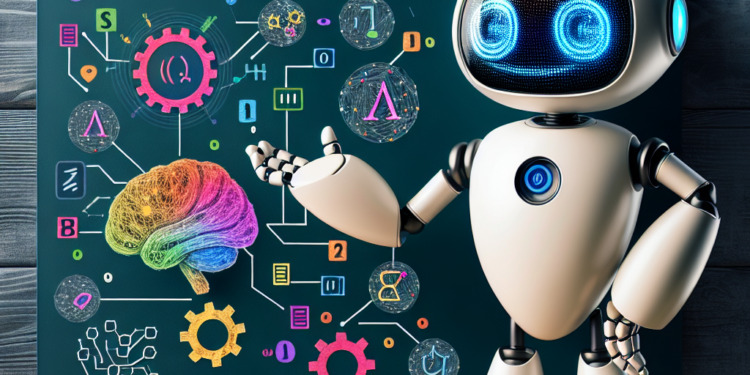Artificial Intelligence, or AI, is a branch of computer science that deals with the creation of intelligent machines that can perform tasks that typically require human intelligence. AI has been a rapidly growing field in recent years, with applications ranging from self-driving cars to intelligent virtual assistants. For beginners looking to understand AI concepts, it can be overwhelming with the technical jargon and complex algorithms. In this article, we will simplify some of the key concepts of AI for beginners.
Machine Learning
Machine learning is a subset of AI that enables machines to learn from data without being explicitly programmed. In other words, machine learning algorithms use data to learn patterns and make decisions without human intervention. There are three main types of machine learning: supervised learning, unsupervised learning, and reinforcement learning.
Supervised learning involves training a model on a labeled dataset, where the algorithm learns to map inputs to outputs based on examples. For example, a supervised learning algorithm can be trained to classify images of cats and dogs based on labeled training data.
Unsupervised learning, on the other hand, involves training a model on unlabeled data to identify patterns and relationships in the data. Clustering algorithms, which group similar data points together, are a common example of unsupervised learning.
Reinforcement learning is a type of machine learning where an agent learns to make decisions by interacting with its environment and receiving feedback in the form of rewards or punishments. The agent learns to maximize its rewards over time by exploring different actions and learning from the consequences.
Neural Networks
Neural networks are a key concept in AI that mimics the way the human brain processes information. They are composed of layers of interconnected nodes, or neurons, that process input data and make predictions. Neural networks are commonly used in tasks such as image recognition, natural language processing, and speech recognition.
The most common type of neural network is a feedforward neural network, where data flows in one direction from the input layer to the output layer. Each neuron in a neural network applies a mathematical operation to its input data and passes the result to the next layer of neurons. The output layer produces the final prediction or classification.
Deep Learning
Deep learning is a subset of machine learning that uses neural networks with multiple layers, also known as deep neural networks. Deep learning algorithms have been shown to outperform traditional machine learning algorithms in tasks such as image recognition and speech recognition.
Deep learning models are typically trained on large amounts of data using techniques such as backpropagation, which adjusts the weights of the neural network to minimize prediction errors. Deep learning has been successfully applied in a wide range of applications, including self-driving cars, medical diagnosis, and natural language processing.
Natural Language Processing
Natural language processing, or NLP, is a subfield of AI that focuses on enabling computers to understand, interpret, and generate human language. NLP is used in applications such as chatbots, virtual assistants, and sentiment analysis.
One of the key challenges in NLP is understanding the context and semantics of human language. NLP algorithms use techniques such as tokenization, part-of-speech tagging, and named entity recognition to process and analyze text data.
Recurrent Neural Networks
Recurrent neural networks, or RNNs, are a type of neural network that is designed to model sequential data, such as time series or natural language data. Unlike feedforward neural networks, RNNs have connections that allow information to persist over time, making them suitable for tasks such as speech recognition and language translation.
RNNs have a unique architecture that includes hidden states, which store information about previous inputs. The hidden states allow RNNs to capture dependencies between inputs and generate context-aware predictions. However, RNNs have limitations in handling long sequences due to vanishing or exploding gradient problems.
Convolutional Neural Networks
Convolutional neural networks, or CNNs, are a type of neural network that is commonly used in computer vision tasks. CNNs are designed to extract features from images and make predictions based on those features. CNNs have been highly successful in tasks such as image classification, object detection, and facial recognition.
CNNs use convolutional layers, which apply filters to input images to extract features such as edges, textures, and shapes. Pooling layers are used to reduce the dimensionality of the feature maps and improve computational efficiency. The output of the convolutional and pooling layers is passed to fully connected layers for classification.
Artificial General Intelligence
Artificial general intelligence, or AGI, refers to AI systems that have the ability to perform any intellectual task that a human can. AGI is often portrayed in science fiction as highly intelligent machines that can think, learn, and communicate like humans. However, AGI remains a theoretical concept and has not yet been achieved in practice.
AGI research aims to develop AI systems that can perform a wide range of tasks across different domains with human-like intelligence. Achieving AGI requires significant advancements in machine learning, robotics, natural language processing, and cognitive science.
Conclusion
Artificial Intelligence is a vast and complex field that encompasses a wide range of concepts and technologies. In this article, we have simplified some of the key concepts of AI for beginners, including machine learning, neural networks, deep learning, natural language processing, and artificial general intelligence.
By understanding these core concepts, beginners can gain a solid foundation in AI and explore more advanced topics in the field. With the rapid advancement of AI technologies, learning about AI concepts can open up exciting opportunities for innovation and discovery in various industries. Whether you are a student, a professional, or just curious about AI, learning about these concepts can help you navigate the world of artificial intelligence and its potential impact on society.













